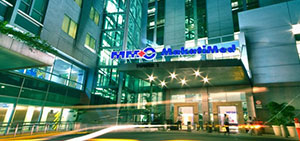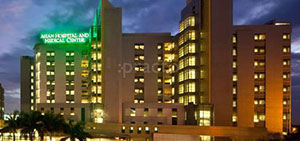WATERBIRTHING: A NEW YET ANCIENT PHILOSOPHY ON CHILDBIRITH
REBECCA B. SINGSON, MD, FPOGS, FPSCPC

Waterbirthing is a non-traditional concept of giving birth which consists of the baby being delivered under water, careful monitoring and management of the process of labor, and restrictive use of invasive methods. The mother’s wishes are prioritized, the natural process of birth is respected, medical intervention and techniques are minimized as long as the safety of the mother and child are not compromised. The mother usually enters the birthing pool or tub during labor with the water set at body temperature once she goes in to active labor. She may go in and out as she pleases depending on the pace of her labor. She may opt to give birth in the water of out of it. She and her partner decide the process of her birth in conjunction with their doctor or birth attendant.
WHAT ARE THE ADVANTAGES OF WATERBIRTHING FOR LABORING WOMEN?:
Waterbirthing can provide the hydrothermal effects of producing perineal and vaginal relaxation. It also provides hydrokinetic effects of releasing oxytocin from the mother’s brain due to nipple stimulation of water. It minimizes the need for medical intervention because when the woman is relaxed, she experiences less pain, thus leading to less anxiety, which in turn lowers adrenaline levels, encouraging the release of oxytocin and more oxygen flow to tissues.
Compared to a laboring woman lying in bed with the uterus compressing the inferior vena cava (the biggest vein returning blood flow to the heart), water birthing lowers compression of the big vessels. Thus, blood supply to the uterus and the placenta is improved. This results in the fetus benefiting with improved oxygenation. 1
WHAT ARE THE ADVANTAGES FOR BIRTHING WOMEN AND BABY?:
Waterbirthing provides a low-risk alternative to delivering on bed or in a stirrup. The element of water angles the process of birth so it is viewed as a wellness rather than an illness. The process restores the control of the birthing process to the mother. Since the water duplicates the amniotic fluid environment inside the uterus, waterbirthing provides a gentle transition to the world for the baby instead of a violent one. It is said to foster non-violence in the child when he becomes an adult.2
A prospective study of more nearly 6,000 mothers giving birth was performed at the clinic for obstetrics & gynecology of the cantonal hospital of Fauenfeld, Switzerland comparing over 2000 waterbirths to other methods of delivery like the Maia-birthing stool, birthing bed, Roma wheel, and others. It was noted that waterbirthing was the most popularly chosen alternative birth method adopted by 34-40% of mothers with spontaneous single births. It was found that the episiotomy rates were lowest after waterbirths and the 3rd and 4th degree lacerations occurred less frequently than bedbirths.
There is also significantly lower blood loss in waterbirths which could be due to the lower incidience of perineal lacerations and the hydrostatic pressure in t the tub preventing vessels from bleeding.
Women who delivered by waterbirthing needed less painkillers compared to any other birth method. This had to do with the relaxing effects of water and the facilitated movement in its weightlessness.
The results in the neonates’ birth parameters such as pH of the arterial umbilical cord blood and Apgar scores were better than other birth methods. In over 2000 waterbirths in the study, there was not a single case of aspiration, drowning or death as a result of waterbirthing.
WHAT ARE THE CONTRAINDICATIONS TO WATERBIRTHING?
Waterbirthing is contraindicated in the presence of any documented fetal distress. Maternal fever of greater than 100.4 of suspected maternal infection or amnionitis or a positive HIV status also contraindicate waterbirthing. Vaginal, urinary tract and skin infections, excessive vaginal bleeding, heavy meconium staining or any conditions requiring continuous electronic fetal monitoring are also contraindications. Prematurity of the fetus and malpresentation also contraindicates waterbirthing. 1
WON’T MY BABY ASPIRATE OR DROWN DURING WATERBIRTHING?
There is no valid report of a neonate that ever drowned or died after birth as a consequence of a waterbirth.3 This has been explained by the diving reflex – and inhibitory reflex associated with the larynx. The larynx has been found to have 5x more taste buds than the whole tongue surface. When any liquid reaches the back of the throat, the taste buds interpret what substance it is and the glottis closes automatically so the liquid is swallowed, not inhaled. This reflex, which is present in all babies till age six to eight months to facilitate breastfeeding, prevents water aspiration.4
So under normal circumstances, the baby won’t breathe or gasp under water. It is only if the fetus was experiencing severe and prolonged lack of oxygen or because on anesthesia, that it may then gasp as soon as it is born, possibly inhaling water into the lungs.5
The baby continues to breathe while underwater through the placenta until the baby is brought out of the water. It is only when the face comes in contact with air that the first breath will be taken. One possibility why a baby would lack oxygen under water, though, would be if the placenta detached prematurely as in the case of abruptio placenta.
WON’T THE MOTHER OR BABY GET INFECTED?
Some hospital restrict a woman with a ruptured waterbag to do waterbirthing. There is really no basis for that since the research shows that the water does not enter the vaginal canal. In 1960, Dr. Siegel reported in the American Journal of OBGyn that when he did experiments on 30 moms to place tampons in the vaginal then have the mom sit in a tub of iodinated water for 15 mins., not one tampon became stained in all cases. He, thus, concludes that women should not be restricted from bathing in the later stages of labor.6
Infections of the neonate were not more frequent with a waterbirth delivery than any other birth method in over 2000 babies studied.3 There are some studies, though that show otherwise. 7.8
Studies show that women who give birth in water have the most satisfying birth experience.3 Waterbirthing is more a philosophy on nonintervention than a method of giving birth. It embodies spiritual, psychological, technological, humanitarian and scientific aspects of birth that make a mother completely connected to her body. It requires a certain level of consciousness and responsibility to take over her birth process and work with her doctor to avoid untoward outcomes that will jeopardize her baby. Waterbirthing is as ancient as it is new. Water allows us to surrender to the greatest miracle that can happen to a woman. The miracle of childbirth.

- Rossi A, Cornette J, Johnson MR, et al. Quantitative cardiovascular magnetic resonance in pregnant women: cross-sectional analysis of physiological parameters throughout pregnancy and the impact of the supine position. J Cardiovasc Magn Reson. 2011;13:31.
- 2 http://www.gentlebirth.org/archives/watrbrth.html. Birth Without Violence. Frederick Leboyer
- Geissbuhler Verena, Eberhard Jakob, Waterbirths: A Comparative Study. Fetal Diagn Ther 2000:15:291-300.
- Harding, R., Johnson, P., McClelland, M. (1978) Liquid sensitive laryngeal receptors in the developing sheep, cat and monkey. J of Physiol 277:409-22.
- Fewell, J.E. Johnson, P., Mc Clelland, M. (1983). Upper airway dynamics during breathing and during apnea in fetal lambs. J of Physiol 339:495-504.
- Siegel, P. (1960), Does Bath water enter the vagina? Journal of Obstet & Gynecol 15:660-1.
- Rawal J. Shah A, Stirk F, Mehtar S: Waterbirth and infection in babies, BMJ 1994;209-511
- Hawkins S: Water vs. conventional births; Infection rates compared. Nurs Times 1995-91:38-40.





